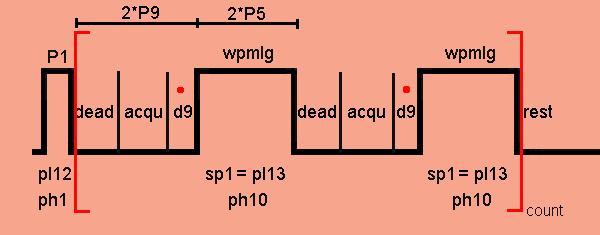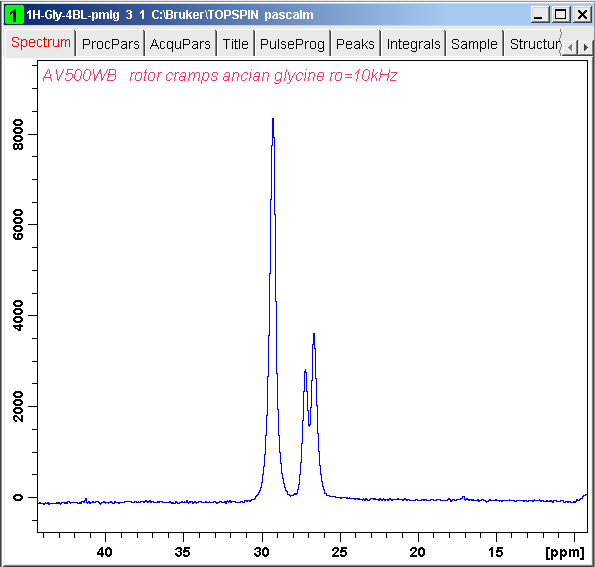
wpmlgd2: homonuclear dipole-dipole windowed-pmlg decoupling pulse program for TopSpin2.1

;wpmlgd2 (TOPSPIN 2.1) ;windowed PMLG homonuclear decoupling, after Leskes, Madhu, and Vega, Chem. Phys. Lett., in press, ;with 180 degree phase alternation ;digital mode ;using shapes for wpmlg ;HF 26.09.07 ;spin 10-15 kHz according to RF field ;set: ;p9 2.4-4.5 usec, depending on probe deadtime, usually: ;for 200 and 300 MHz, CRAMPS probe required or use 4.5 usec ;use digital mode, swh=10-20 kHz ;before ft, set s sw=sw/0.47 ;set: ;d1 : recycle delay ;p1 : proton 90 degree pulse at pl12 ;set o1p around 10 ppm or -4 ppm, usually better on left side of spectrum ;pl12 : power level for initial pulses ;pl13 : power level for pmlg, set cnst20 to RF field at pl13, for simplicity, use pl13=pl12 ; sensible proton RF-field: 80 000 Hz for 300-400 MHz proton frequency, 100000 for 500-600 MHz ; 120000 for 600 MHz and higher (due to probe bandwidth differences) ;ns=n*4 ;spnam1=m5m or m3m, m5p or m3p ;p5 is the 294 degree pulse ;shape consists of 10 (6) slices of length 2*p5/10 (/6), ;set cnst20 for approximate RF field, adjust power for best result, ;shape duration recalculated so slice is a multiple of 100 ns ;set l11=number of oversampled datapoints to be sampled, 8-32 depending on ; available window, check acqu in ased for sensible value. ;n.b.: scaling factor differs from wpmlg! ;$COMMENT=homonuclear decoupling with w-pmlg ;$CLASS=Solids ;$DIM=1D ;$TYPE=homonuclear decoupling ;$SUBTYPE=explicit acquisition ;cnst11 : to adjust t=0 for acquisition, if digmod = baseopt "acqt0=1u*cnst11" dwellmode auto #include <Avancesolids.incl> #include <Delayssolids.incl> #include <lgcalc.incl> /*;set cnst20 to RF field at pl13, wpmlg pulse calculated as multiple of 100 ns */ "sp1=pl13" "d3=p9" ;p9 sets the window to make sure it is in micorseconds "d9=0.1u*(l11)" ;set the sampling window in Avancedru.incl "blktr2 = 0.7u" ;this opens the transmitter gate 0.7 usec before the ;pulse, so the transmitter noise is not sampled define delay dead "dead=1.2u" define delay acqu ;small window, defined by d3, 2.5-4.5 usec depending "acqu=2*p9-1.2u-d9-.1u" ;on probe deadtime large window-sampling period ;make sure shape slice durations are a multiple of 0.1 usec define loopcounter smooth "smooth=10*p5" define pulse polish "polish=1u*smooth/10" define pulse wpmlg "wpmlg=2*polish" define delay cycle "cycle=4*p9+2*wpmlg+.2u" define loopcounter count "count=aq/cycle" ;make sure td datapoints are sampled define delay rest ;make sure sampling proceeds throughout the sequence "rest=aq-(count*cycle)" 1 ze ;acquire into a cleared memory 2 d1 pl12:f1 ;recycle delay, set power level for the first pulse 10u reset1:f1 ;synchronise pulse and detection RF STARTADC ;prepare adc for sampling, set reference frequency, defined in Avancedru.incl RESETPHASE ;reset reference phase 1u rpp10 ;reset phase list pointer p1:f1 ph1 ;first 90 at pl12 .1u DWL_CLK_ON 4 dead acqu d9 RG_ON .1u RG_OFF ;take l11 complex data points (wpmlg:sp1 ph10^):f1 ;select shape dead acqu d9 RG_ON .1u RG_OFF (wpmlg:sp1 ph10^):f1 lo to 4 times count ;make sure td points are sampled rest 1u DWL_CLK_OFF rcyc=2 ;next scan 5 100m wr #0 ;save data 6 exit ;finished ph0= 0 ph1= 0 1 2 3 ph10=0 2 ph30=0 ;needed for acquisition, involved in RESETPHASE ph31=0 1 2 3 ;involved in STARTADC

1H windowed PMLG5 spectrum of glycine in a 4-mm diameter, 12-µL HRMAS rotor spinning at 10 kHz; P5 = 7 µs.
Pulseprogram parameters for dumbod2:
| General | |
| PULPROG | wpmlgd2 |
| TD | 700 |
| NS | 4 |
| DS | 0 |
| SWH [Hz] | 20000.00 |
| AQ [s] | 0.0175750 |
| RG | 4 |
| DW [µs] | 25.000 |
| DE [µs] | 4.50 |
| CNST11 | 0.0000000 |
| CNST20 | 116600.0000000 |
| CNST21 | 1.0000000 |
| CNST22 | 1.0000000 |
| CNST23 | 1.0000000 |
| CNST24 | 1.0000000 |
| D1 [s] | 5.00000000 |
| D3 [s] | 0.00000300 |
| d9 [s] | 0.00000300 |
| L11 | 30 |
| p5 [µs] | 7.00 |
| P9 [µs] | 2.60 |
| PL13 [dB] | 5.00 |
| acqu [s] | 0.00000090 |
| count | 455 |
| cycle [s] | 0.00003860 |
| dead [s] | 0.00000120 |
| polish [µs] | 7.00 |
| rest [s] | 0.00001200 |
| smooth | 70 |
| Channel f1 | |
| NUC1 | 1H |
| P1 [µs] | 2.00 |
| PL1 [dB] | 3.80 |
| PL12 [dB] | 3.80 |
| SFO1 [MHz] | 500.2145808 |
| SP1 [dB] | 5.00 |
| SPNAM1 | m5m |
| SPOAL1 | 0.500 |
| SPOFFS1 [Hz] | 0.00 |
| wpmlg [µs] | 14.00 |